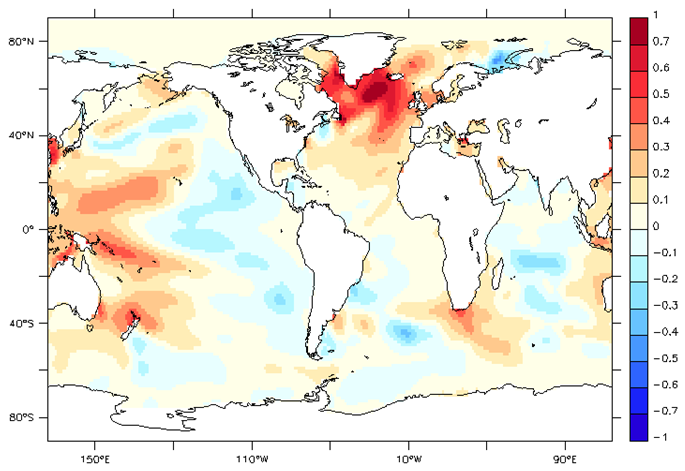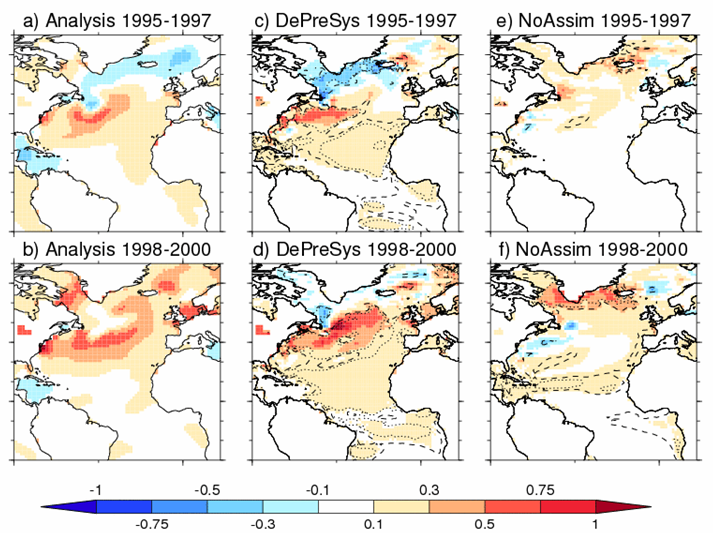The Earth is a complex system of interacting components, such as the atmosphere and ocean, which produce a wide variety of natural variability. This natural variability ensures that the evolution of a particular region’s climate, e.g. that of Western Europe, could be completely different to another region, or indeed the global mean climate. Such variability can impact on many areas of society; for example winter energy usage, or agriculture in sensitive regions.
Post by Jon Robson
Of course, institutions around the world, like the Met Office, are trying to predict this variability, especially on monthly to seasonal timescales. However, recently there has been an increasing focus on predicting at multiannual to decadal timescales. You may be surprised to find that, usually, climate projections make little use of the current observed climate state. This is partly because initial conditions matter little to projections of the climate in 2100, which instead try to convey the likely range of climate states that may occur given a particular emission scenario. However, over the next few years, and maybe up to a decade or two ahead, it may be possible to predict whether certain climate patterns are more likely to occur than others.
A good example of multidecadal variability is the observed changes in the North Atlantic. Over the past 20 years the North Atlantic has warmed significantly. This is especially true for the subpolar North Atlantic (between 50-70N), which went from anomalously cold to anomalously warm following the mid 1990s (see Figure 1), and was associated with significant weakening of the subpolar North Atlantic circulation. These recent changes in North Atlantic heat content represent a return to the positive phase of the Atlantic Multidecadal Oscillation, which may have impacts on North American and European climate, and may have been important for changes in the numbers of hurricanes. So, what’s going on here?

From the 1950s to the mid 1990s the heat content of the subpolar North Atlantic actually decreased significantly. This cooling can be largely understood as a direct response to the atmospheric forcing. During this time the North Atlantic Oscillation (NAO) index became more positive. Simply put, a positive NAO is associated with stronger winds across the North Atlantic, and hence increased cooling of the ocean due to increased turbulent heat fluxes (sensible and latent). Since the mid 1990s the NAO index has been much more neutral. Thus, the warming of the North Atlantic could simply be explained by a reduced cooling of the ocean. But was that really the case? Such a hypothesis assumes no dynamical changes in the ocean.
There is already significant evidence, largely from models, that dynamical ocean changes should be expected in response to the NAO. For instance the oceans circulation is largely driven by the curl of the wind stress. Thus, changes in winds can change the ocean circulation, and the northward heat transport of the Atlantic. But in the North Atlantic, it is not just the curl of the wind stress that is important for the circulation. Many model studies suggest that decadal changes in the Atlantic Meridional Overturning Circulation (AMOC), an important ocean current that transports heat northward throughout the whole Atlantic, could follow persistent positive NAO events. This is because the convective formation of deep water at high latitudes, which is important to sustain the AMOC, usually increases following increased cooling.
To try and understand the cause of the warming we performed a few experiments to look at this event using an ocean-only model that was forced with the historical wind stress and buoyancy fluxes (heat flux and precipitation). The experiments support the view that the warming of the North Atlantic was primarily due to changes in ocean heat transport that followed the positive NAO, and not simply the changes in local surface heat fluxes. Furthermore, the experiments also strongly suggest that a buoyancy forced strengthening of the AMOC played a key role.
Given that the warming of the North Atlantic was not just an instantaneous response to the atmospheric forcing then it is encouraging for the prospects multi-year predictions. This conclusion is supported by an analysis of the Met Office’s Decadal Prediction System (DePreSys). Predictions started immediately prior to the warming seem to be able to predict the warming well (see Figure 2), whereas predictions that do not assimilate observations (NoAssim: think typical IPCC type climate projection) do not. Importantly, the initialisation of a strong ocean circulation, and particularly a strong AMOC, appears key to deliver successful predictions.
It is true to say that this is not yet a fully understood story; there are still some key uncertainties. For example, what is more important for driving the subpolar Atlantic circulation on multidecadal time scales – wind stress or buoyancy fluxes? The results seem to be somewhat dependent on the model used in each study. There are also large uncertainty as to the role of the forcing, especially the aerosol, which varies significantly in time. However, the key question is how much, if at all, these changes in the North Atlantic have had an impact over land, and could we predict it? Such a question can be challenging to answer, given all that is occurring in the climate system. Analysis here is ongoing, however, initial results are encouraging.

Robson, J., Sutton, R., Lohmann, K., Smith, D., & Palmer, M.D. (2012). Causes of the Rapid Warming of the North Atlantic ocean in the mid 1990s Journal of Climate, in press : http://dx.doi.org/10.1175/JCLI-D-11-00443.1
I realize you are talking about the sub-polar North Atlantic here but presumably this has implications for the Arctic, a region undergoing well documented change. Do you have any insights on how dynamical changes in the Atlantic are altering energy avection from the Atlantic to the Arctic?